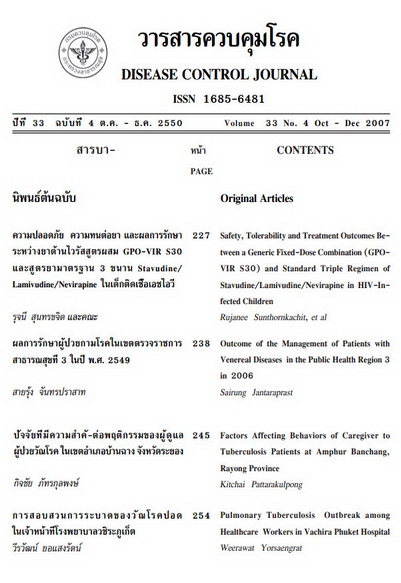Safety, Tolerability and Treatment Outcomes Between a Generic Fixed-Dose Combination (GPO-VIR S30) and Standard Triple Regimen of Stavudine/Lamivudine/Nevirapine in HIV-Infected Children
Keywords:
GPO-VIR S30, Nevirapine, Safety of drugs, HIV-infected childrenAbstract
This study aimed to compare safety, tolerability and treatment outcomes between HIV-infected children who received fixed-dose combination of stavudine (d4T), lamivudine (3TC) and nevirapine (NVP) named GPO-VIR S30 with the standard separated triple regimen of d4T/3TC/NVP. Fifty naïve HIVinfected children aged under 15 years were randomized into 2 groups, 25 children in each group. The study group received GPO-VIR S30 that cut into the fraction of ¼, ½, ¾, and entire tablet. The dosage was calculated based upon NVP dose of 120-200 mg/m2. The control group received d4T 1 mg/kg, 3TC 4 mg/kg and NVP 160-200 mg/m2. The results showed that one (4%) child in GPO-VIR S30 group and two (8%) in d4T/3TC/NVP group needed to change NVP due to severe skin rash (P = 0.552). The percentage of skin rash grade 1-2 was 15.8% in GPO-VIR S30 group and 9.5% in d4T/3TC/NVP group (P = 0.550). Two and one children in the study group and control group respectively (P = 0.552) died. Immune reconstitution syndrome (IRS) was diagnosed in one case in study group and 4 cases in control group (P = 0.157). Nineteen (76%) children in study group and 21 (84%) in the control group continued antiretroviral therapy through 12 months (P = 0.480). The children receiving d4T/3TC/NVP had significantly higher rate of nausea/vomiting than GPO-VIR S30 group (P = 0.045). The immunologic outcomes (CD4) at 6 and 12 months were not different between the two groups (P = 0.503, P = 0.851). By OT analysis at 12 months of treatment, 73.7% of study group and 38.1% of control group had HIV-1 RNA <50 copies/mL, P = 0.024. However by ITT, there was no significant in this outcome, 56% versus 32%, P = 0.087. This study indicated that divided GPO-VIR S30 tablet for HIV-infected children was safe, well tolerate and effective as standard separated triple regimen of d4T/3TC/NVP.
Downloads
References
2. Puthanakit T, Oberdorfer A, Akarathum N, Kanjanavanit S, Wannarit P, Sirisanthana T, et al. Efficacy of highly active antiretroviral therapy in HIV-infected children participating in Thailand's national access to antiretroviral program. Clin Infect Dis. 2005 Jul 1; 41: 100-7
3. O'Brien DP, Sauvageot D, Zachariah R, Humblet P. In resource-limited setting good early outcomes can be achieved in children using adult fixed-dose combination antiretroviral therapy. AIDS. 2006; 20: 1955-1960
4. Janssens B, Raleigh B, Soeung S, Akao K, Te V, Gupta J, et al. Effectiveness of highly active antiretroviral therapy in HIV-positive children: Evaluation at 12 months in routine program in Cambodia. Pediatrics. 2007. Nov; 120: 1134-40
5. Havlir D, McLaughlin MM, Richman DD. A pilot study to evaluate the development of resistance to nevirapine in asymptomatic human immunodeficiency virus-infected patients with CD4 cell counts of > 500/mm3: AIDS Clinical Trials Group Protocol 208. J Infect Dis. 1995; 172: 1379-83
6. Chokephaibulkit K, Plipat N, Cressey TR, Frederix K, Phongsamart W, Capparelli E, et al. Pharmacokinetics of nevirapine in HIVinfected children receiving an adult fixed-dose combination of stavudine, lamivudine and nevirapine. AIDS. 2005; 19: 1495-9
7. World Health Organization. Antiretroviral therapy of HIV infection in infants and children in resource-limited setting:towards universal access. Recommendations for a public health approach 2006.Geneva; World Health Organization: 134-5
8. Manosuthi W, Sungkanuparph S, Thakkinstian A, Rattanasiri S, Chaovavanich A, Prasithsirikul W, et al. Plasma nevirapine levels and 24-week efficacy in HIV-infected patients receiving nevirapine-based highly active antiretroviral therapy with or without rifampicin. Clin Infect Dis. 2006; 43: 253-5
9. Manosuthi W, Ruxrungtham K, Likanonsakul S, Prasithsirikul W, Inthong Y, Phoorisri T, et al. Nevirapine levels after discontinuation of rifampicin therapy and 60-week efficacy of nevirapine-based antiretroviral therapy in HIVinfected patients with tuberculosis. Clin Infect Dis. 2007; 44: 141-4
10. กรมควบคุมโรค กระทรวงสาธารณสุข,สมาคม โรคเอดส์แห่งประเทศไทย,สมาคมโรคติดเชื้อ ในเด็ก. แนวทางการดูแลรักษาผู้ติดเชื้อเอชไอวี และผู้ป่วยเอดส์ในประเทศไทยปี พ.ศ. 2549/ 2550: 44
11. Centers for Disease Control and Preven tion.1994 Revised classification system for human immunodeficiency virus infection in children less than 13 years of age. MMWR 1994; 43(RR-12): 1-10
12. Working Group on Using Weight and Height References in Evaluating the Growth Status of Thai Children. Manual on using weight and height references in evaluating the growth status of Thai children. Bangkok: Department of Health, Ministry of Public Health, 2000.
13. Divisions of AIDS, National Institute of Allergy and Infectious Diseases. Division of AIDS table for grading the severity of adult and pediatric adverse events. Publish date December 2004. Available at: http://www.fda.gov/ OHRM/DOCKETS/dockets/05d0155/05d- 0155-e000005-01-vol1.pdf. Accessed 28 December 2004.
14. Puthanakit T, Oberdorfer P, Akarathum N, Wannarit P, Sirisanthana T, Sirisanthana V. Immune reconstitution syndrome after high active antiretroviral therapy in human immunodeficiency viru- infected Thai children. Pediatr
Infect Dis J. 2006; 25: 53-8
Downloads
Published
How to Cite
Issue
Section
License
Articles published in the Disease Control Journal are considered as academic work, research or analysis of the personal opinion of the authors, not the opinion of the Thailand Department of Disease Control or editorial team. The authors must be responsible for their articles.


.png)



